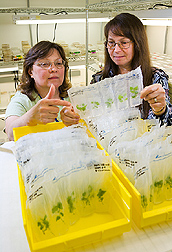This page has been archived and is being provided for reference purposes only. The page is no longer being updated, and therefore, links on the page may be invalid.
Read the magazine story to find out more. |
|
|
Ironing Out Storage Kinks for Hops
By Laura McGinnisJanuary 17, 2008
To help breeders improve hops for brewing and other U.S. industries, the Agricultural Research Service (ARS) National Clonal Germplasm Repository (NCGR) maintains a diverse hop collection at Corvallis, Ore. There, scientists and curators maintain germplasm—genetic material such as plants, shoot tips and seeds—from more than 150 hop varieties collected from over 24 countries, from the Yugoslavian Ahil to the Czech Zlatan.
They cultivate about 250 accessions as potted plants and preserve 57 accessions as tissue cultures. Thirty accessions are also cryopreserved—stored frozen in liquid nitrogen for extended periods—at the National Center for Genetic Resources Preservation in Fort Collins, Colo. The tissue cultures can be stored at about 39 degrees Fahrenheit for two years or longer.
Plant physiologist Barbara Reed and NCGR colleagues investigated how 12 hops genotypes responded to the iron formulation used in the culture medium during storage. Their observations have led to improved storage techniques.
Just as an adult recovering from surgery and a teenager preparing for a marathon will have different dietary needs, the nutrient requirements of plants vary according to their developmental stage and storage environment. Identifying the precise requirements is essential to successful germplasm storage.
In the past, NCGR scientists noticed that hop cultures stored on a standard medium containing a moderate level of iron sometimes emerged iron-deficient when grown out later. They learned that adding sequestrene iron to the growth medium enabled most cultured plants to grow better.
But Reed and her colleagues also observed something paradoxical about the iron-rich media. Although most hops cultivars grew better in an iron-rich culture, the scientists found that they stored better in an environment with less iron.
The researchers have since modified their storage procedure accordingly, reducing the iron content of the plants' media about a month before storage. This reduces iron deficiency without compromising the accessions’ storage life.
Read more about this research in the January 2008 issue of Agricultural Research magazine.
ARS is the U.S. Department of Agriculture's chief in-house scientific research agency.


